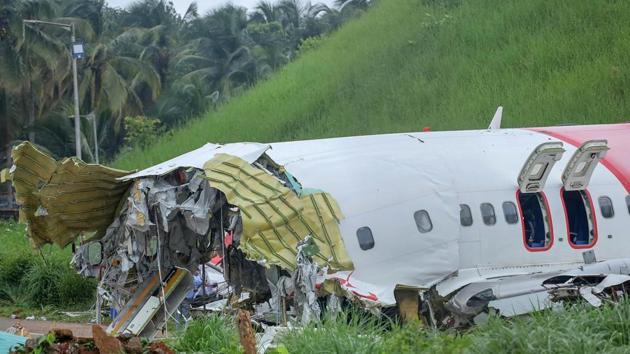Kozhikode crash puts spotlight on tabletop runway risks
Concerns were raised following the 2010 Air India Express crash in Mangalore that killed 158 people on board. That year, a court of enquiry report by a former Indian Air Force chief Air Marshal BN Gokhale noted that tabletop runways require extra skill and caution.
The crash involving an Air India Express plane that was attempting to land amid heavy tailwinds and rain on a tabletop runway at the Kozhikode airport has once again shone light on safety concerns over flight operations in such conditions.

Concerns were raised following the 2010 Air India Express crash in Mangalore that killed 158 people on board. That year, a court of enquiry report by a former Indian Air Force chief Air Marshal BN Gokhale noted that tabletop runways require extra skill and caution. The hazard of “undershooting” and “overshooting”, in particular, can lead to grave situations, the report said.
“While the length of the runway 24/06 (in Mangalore) is adequate for operations by aircraft such as Airbus A320 and Boeing 737-800, the downward slope at end of R/W 24 leading into hill slope is not recommended if one is to consider the hazards of overshooting the paved surface during takeoff or landing...,” the report, submitted in October 2010, said.
Also read| Kozhikode plane crash: Flight was shaking, it was a nightmare, recount survivors
“There are three tabletop airports in India from where scheduled flights operate. These are Mangalore, Kozhikode and Lengpui. Because of the undulating terrain and constraints of space, these airfields require extra skill and caution while carrying out flight operations. The hazard of undershooting and overshooting, in particular, can lead to grave situations, as was the case in this accident (in Mangalore). These table-top runways also have a problem of access roads around the airfield, which may need to be used in case of aircraft accidents,” it added.
The narrow and winding roads can delay and hinder rescue operations, the report said.
So-called tabletop airports have limited space at the ends of the runway, and several international airlines have stopped flying bigger aircraft into Kozhikode due to safety issues.
The Air India Express flight with 190 on board overshot and fell 50 metres off the end of the runway at the Kozhikode airport in treacherous conditions on Friday, breaking into two — making it one of the deadliest commercial aviation disasters in the country in nearly 10 years.
The crash occurred around 7.40pm, when it was raining. The incident bears eerie similarity to the 2010 Mangalore airport crash when a plane, also an Air India Express Boeing 737, overshot a table-top runway and crashed nose-first into the ground.
According to Robert A Clifford, lead counsel in the case against Boeing for the last major Boeing crash — the 737 Max 8 accident in Ethiopia on March 10, 2019 — and senior partner of Clifford Law Offices, Chicago, the investigation into what caused Friday’s Air India crash will likely focus on the plane itself and pilot error.
“The weather being involved probably speaks to pilot flight error, but the aircraft’s safety systems could have played a role. Investigators will need to evaluate the flight data recorder, cockpit voice recorder, and other devices, along with expert evaluation, to determine what happened,” he said.
DGCA has classified certain airfields as critical that need special qualification for the flight crew to undertake operations. The criteria for classifying airfields as critical are based on various factors such as terrain, length of runway, predominance of inclement weather etc.
Also read| Part of parameter wall demolished, cockpit cut open to pull out pilots: Rescuers
“There are 11 such airfields, which include the tabletop runways of Mangalore, Kozhikode and Lengpui. In addition, airfields such as Patna, Jammu, Leh, Port Blair etc. also qualify as ‘critical airfields’. The operators can add some more airfields as critical, in case additional caution needs to be exercised during operations. As per SOP of Air India Express, three airfields at Mangalore, Kozhikode and Pune qualify as ‘critical airfields’. These airfields are, therefore, cleared for operations by experienced flight crew and take off and landings have to be carried out by the pilot in command (PIC) only,” said the 2010 report by Gokhale.
Following the Mangalore crash, the court of Inquiry recommended setting up of an independent Indian Civil Aviation Safety Board (ICASB) urgently in view of rapid growth of aviation in the country. Such independent safety organisations have been set up in the USA, UK, Canada, France and Indonesia to name a few.
The ICASB will focus on all flight safety related issues to suggest proactive measures, to minimise accidents and incidents, it said.
Back then, the Civil Aviation Safety Advisory Council (CASAC), an independent aviation safety board that was set up in 2011 after the Mangalore crash, also warned authorities that the Kozhikode runway was very risky for landing during rains and harsh weather conditions.






